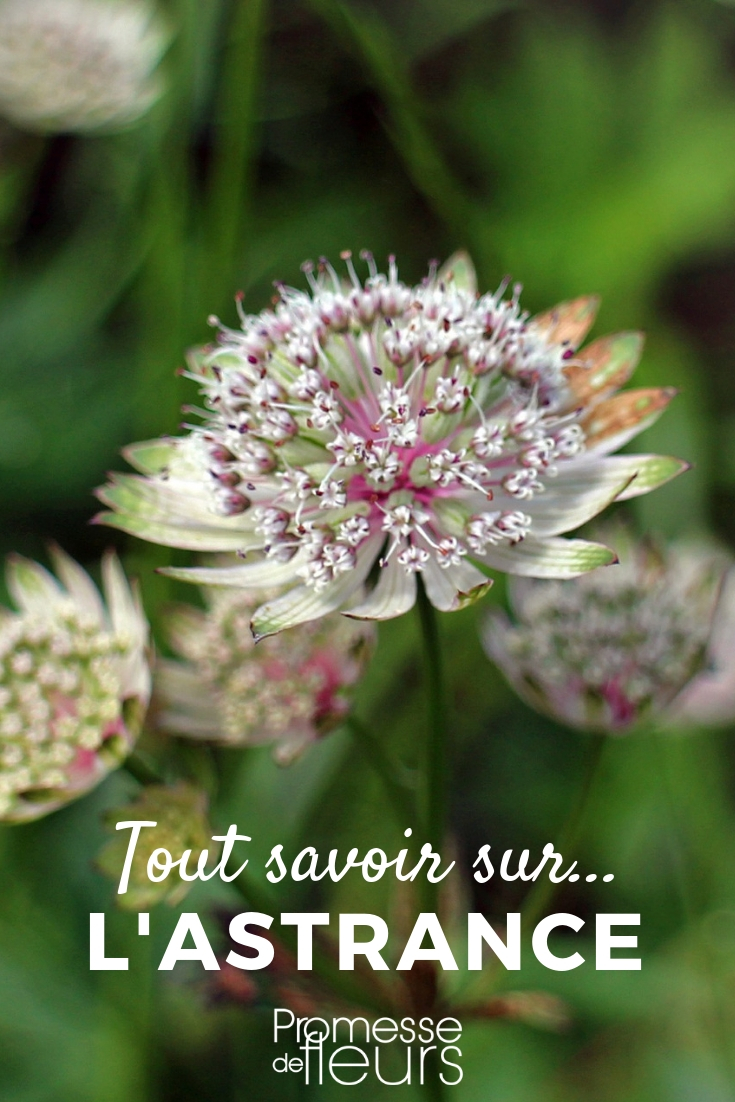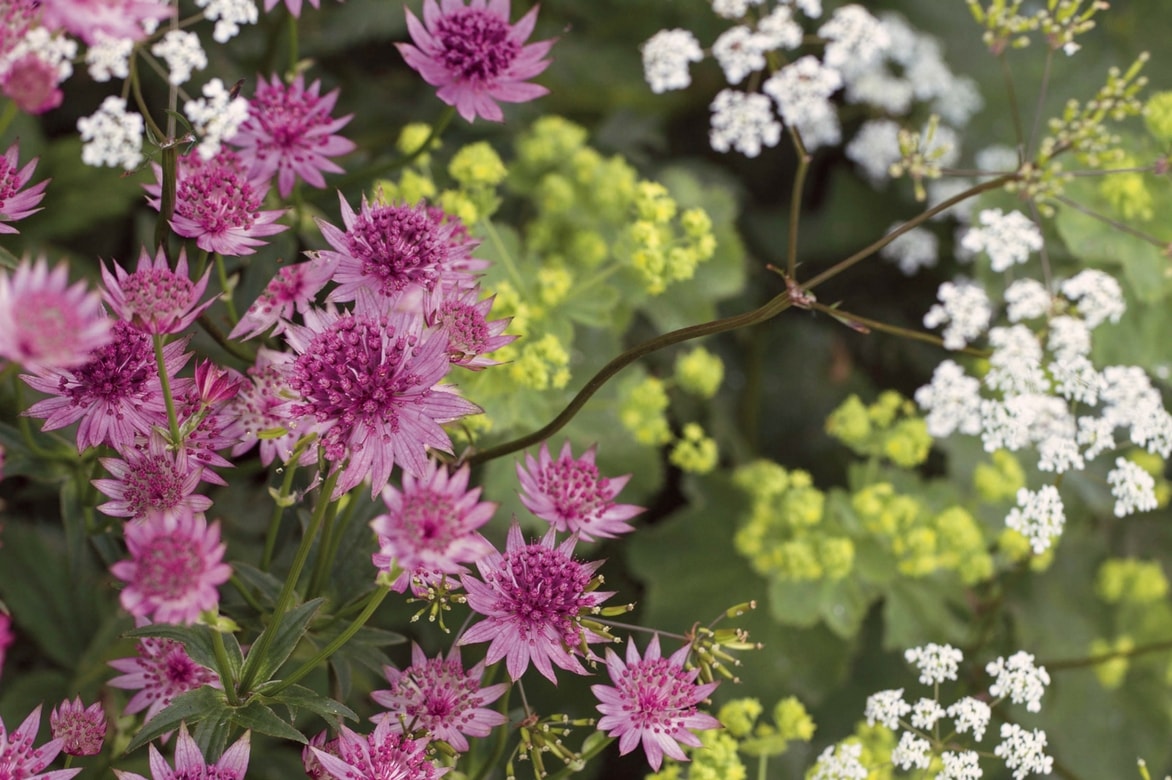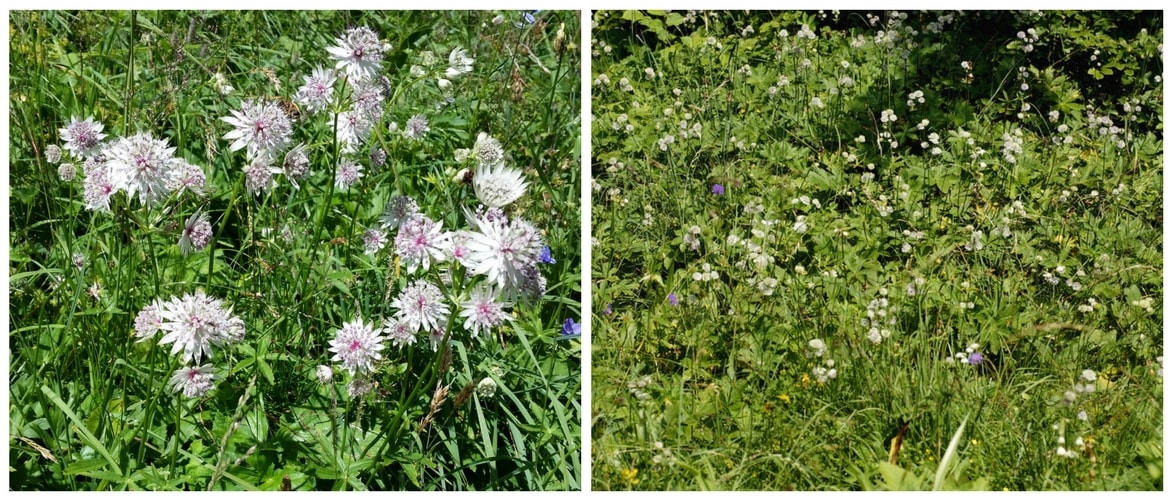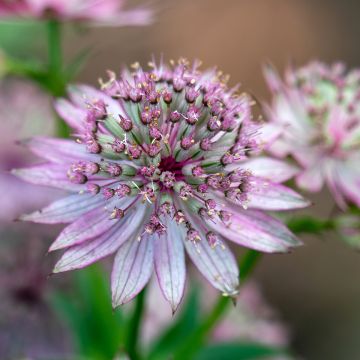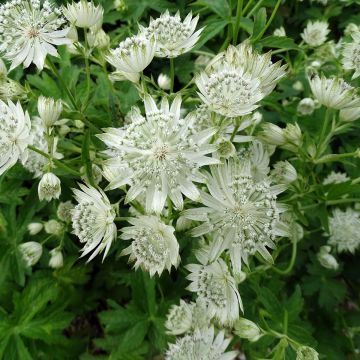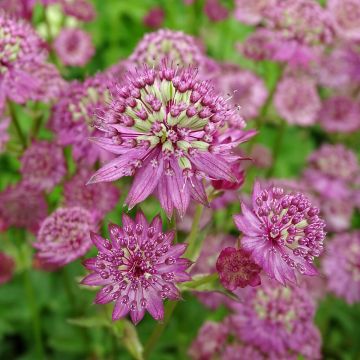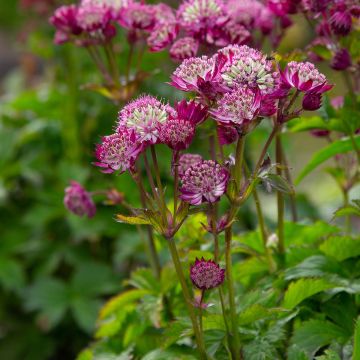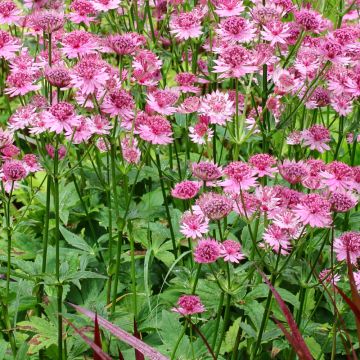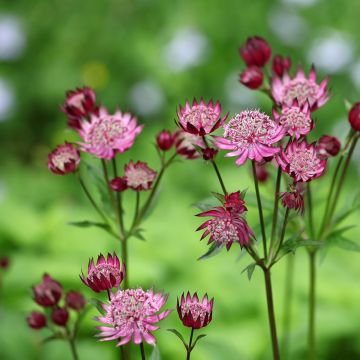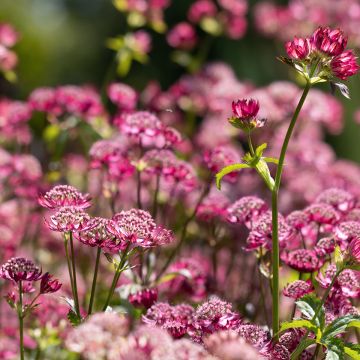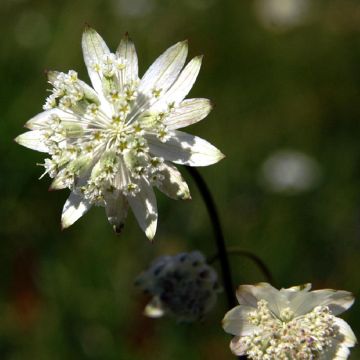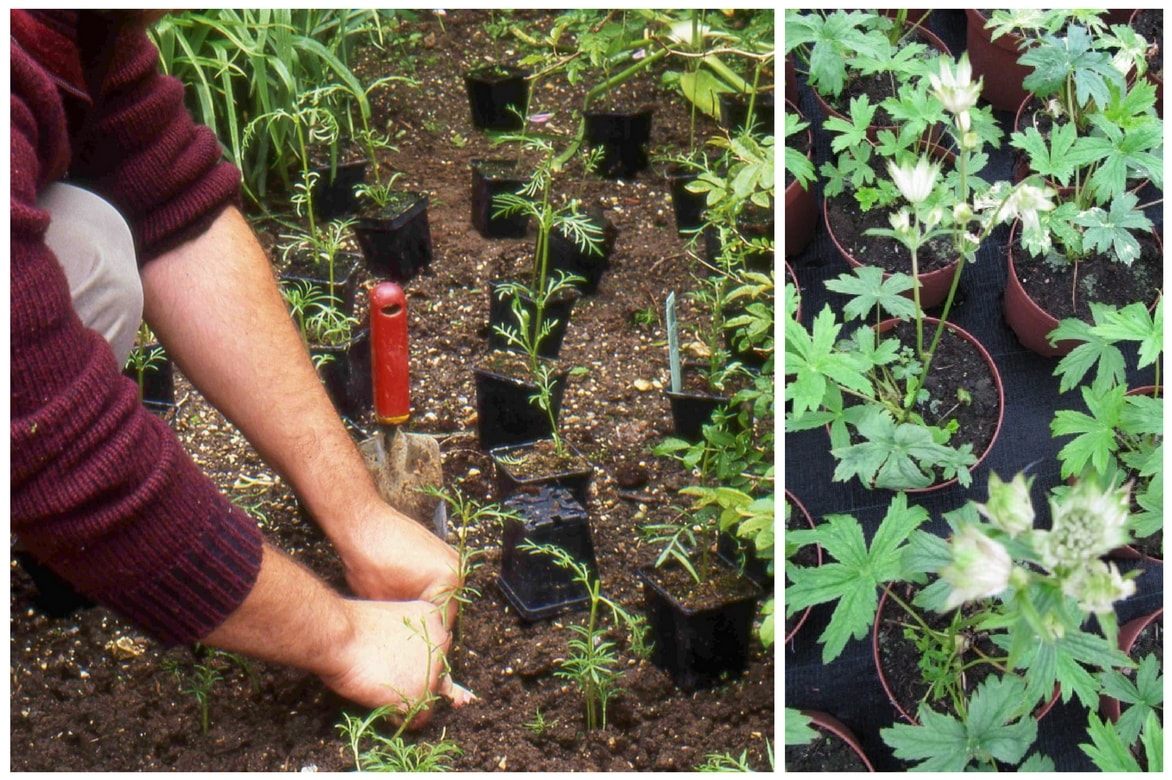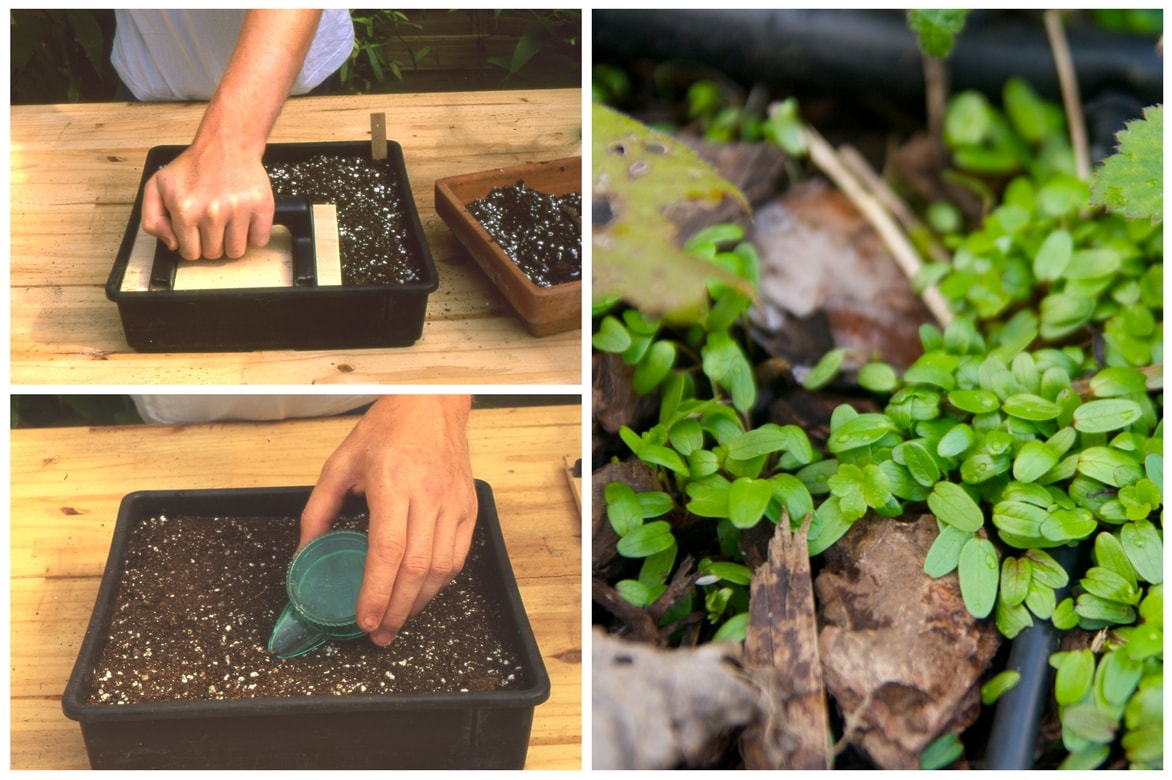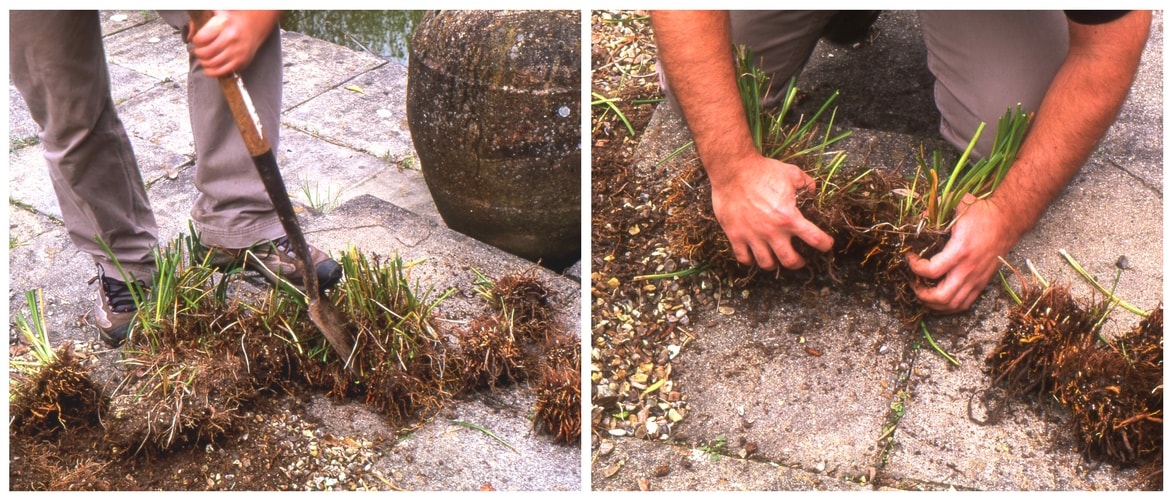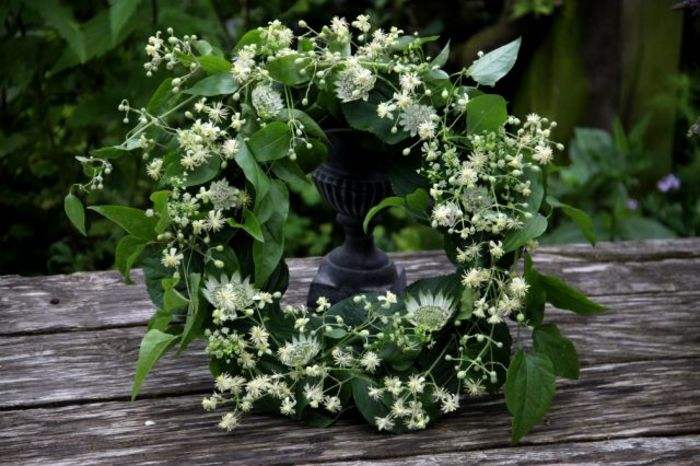
Masterwort: Planting, Care and Companion Planting in the Garden
Contents
Astrantias in a nutshell
- Masterwort is the most beautiful of all partial shade flowers, blooming throughout the summer
- Easy to grow, Astrantia tolerates all soil types and only fears summer drought
- It’s rather tricky to grow from seed (better to use plants), but easy to divide
- Wonderful when combined with perennials, ornamental grasses and shrubs
- An emblem of English gardens, a favourite of many landscape designers… Masterwort is our favourite flower!
Our Expert's Word
Great Masterworts (Astrantia major), classics of English cottage gardens and herb gardens, are highly fashionable among landscapers for prairie-style gardens, prized for their simultaneously wild and sophisticated appearance.
Yet they remain largely unknown to amateur gardeners, for whom ‘Astrance’ rather evokes a (very fine) Parisian restaurant.
Masterworts are one of the most beautiful perennials for partial shade: easy to grow, they flower for a long time, all summer, with magnificent star-shaped umbels in pink, white or red depending on the variety.
Masterwort thrives in rich, moist, well-drained soil in partial shade. Very hardy, this mountain plant found at forest edges and in alpine meadows often takes a year to really establish, but then produces a large clump with dozens of flower stems continuously from June to September. Its only real enemy is summer drought.
Masterwort is extremely versatile in the garden. It pairs well with… almost everything, particularly perennials and roses. It makes beautiful, rustic-looking bouquets.
Botany
Botanical data
- Latin name Astrantia major
- Family Apiaceae
- Common name great masterwort, mountain sanicle, meadow star
- Flowering Flowering from June to September, flowers 2-3 cm in diameter, umbel-shaped inflorescences
- Height 40-70 cm / Spread
- Exposure light shade, partial shade - Tolerates full sun in cool climates and moist soil
- Soil type tolerant, rich and well-drained
- Hardiness below -15°C
Masterwort is native to the mountains of Europe. It is commonly found growing wild at forest edges, in semi-shaded meadows, and in light woodland shade. It sometimes occurs near water when the soil is sufficiently drained; it prefers a fairly shaded position, with morning or late afternoon sun, in rich, fairly moist soil that doesn’t dry out in summer, but is properly drained, as it dislikes having its roots permanently in water.
Belonging to the Apiaceae or Umbelliferae family, Masterwort is a cousin of carrots, Angelica, parsley, and some thistles like Eryngiums, with which it shares the umbel-shaped flowers.
The leaves, of a fairly dark green colour, are palmate in shape, divided into toothed lobes. Some varieties have superb variegated foliage, like the ‘Sunningdale Variegated’.
Masterwort has a fairly dense habit, forming a compact clump about 40 cm in height and width at maturity. The deciduous foliage appears quite late, usually towards the end of March. It begins to wither (turn black) by late summer, disappearing entirely by mid-autumn.
The clump is usually cut back to the base in October, as it is not very attractive in autumn, or in early spring, to encourage the emergence of new foliage.


Different Masterwort foliage types. From left to right: Astrantia major, Astrantia minor, Astrantia Sunningdale Variegated.
A rhizomatous plant, it has a fairly slow growth rate. Planted in pots, it often flowers in the first year but will only form a nice clump after a year of cultivation. If you sow seeds, you’ll need to wait at least two years for good flowering. The clump continues to grow without ever becoming invasive. In favourable conditions, botanical varieties and some horticultural varieties with white and pink flowers self-seed spontaneously.
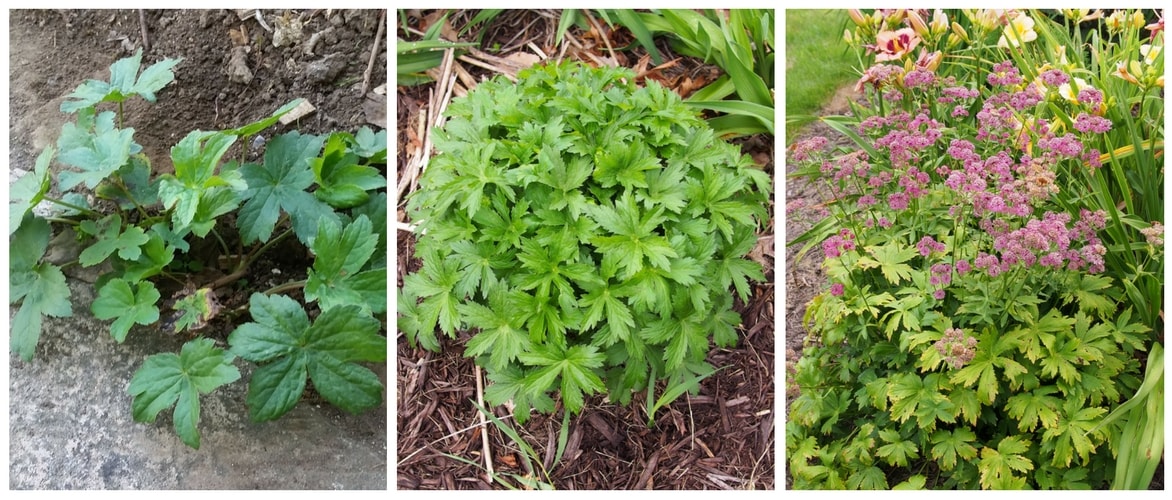

Self-seeded plant growing between paving stones – Masterwort clump in leaf – In flower after 3 years of planting
It is sometimes said that its lifespan is short, around 5 years. This is false. Some of our mother plants are over 15 years old! Dividing the plants helps rejuvenate them.
The Masterwort flowers are borne on long stems about 60 cm tall (40 cm for the shortest, 80 cm for the tallest), branching towards the top into multiple stems, each carrying a flower. The flower stems are sturdy and withstand bad weather well; slender and tall, they sway in the wind, forming a small white or pink cloud of dozens of flowers.
The flowers, about 3 cm in diameter, are a small masterpiece of botanical craftsmanship: the finely cut umbel of tiny flowers is edged with a collar of “petals” (actually bracts), forming a crown.


Various stages of development of the simple inflorescence of Great Masterwort. The bracts at the base surround the fertile flowers composed of pistils and stamens.
The flowers are usually pink or white tinged with anise green or grey in some varieties. Some cultivars are red, verging on purple (‘Hadspen Blood’, ‘Moulin Rouge’), and many have translucent colour nuances of crystalline delicacy.
Flowering generally begins in May or June and ends between July and September. Masterwort blooms for 3, sometimes even 5 months! This longevity is due to the sturdiness of the flower stems, the resilience of the flowers to wind and rain, and the continuous production of new flower stems throughout summer. Cutting back spent flower stems and watering during dry spells encourages repeat flowering all summer long. Varieties like ‘Hadspen Blood’, ‘Star of Billions’ and ‘Roma’ flower quite continuously throughout summer.
As nothing is perfect, Masterwort is not fragrant. However, it is very attractive to pollinators and draws butterflies and other beneficial insects.
Discover Masterwort in video with Olivier:
Main varieties
There are dozens of varieties of Masterworts, where differences often stem more from plant marketing than actual distinctiveness. Nearly all cultivated varieties are Astrantia major. You may also occasionally find Astrantia maxima, with larger flowers (around 5 cm in diameter), Astrantia carniolica, a low-growing species well-suited to cool rockeries, and Astrantia minor, which boasts the smallest flowers.
The main selection criteria are flower colour, height, and flowering period.
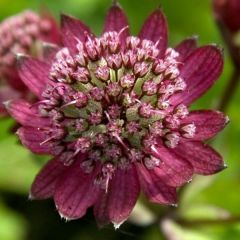
Astrantia major 'Hadspen Blood'
- Flowering time July to October
- Height at maturity 45 cm
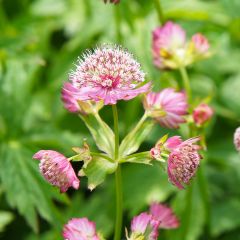
Astrantia major Rosea - Masterwort
- Flowering time July to October
- Height at maturity 60 cm
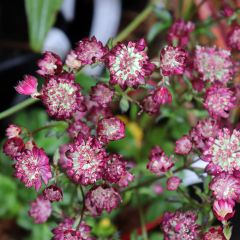
Astrantia Moulin Rouge
- Flowering time July to October
- Height at maturity 60 cm
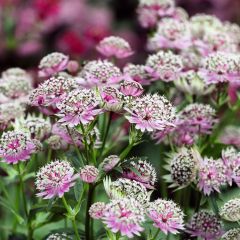
Astrantia major Buckland - Great Masterwort
- Flowering time July to October
- Height at maturity 60 cm
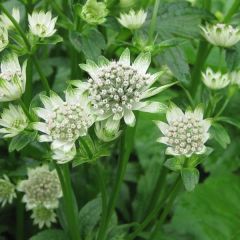
Astrantia major Star of Billion - Masterwort
- Flowering time July to October
- Height at maturity 70 cm
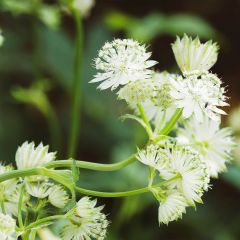
Astrantia major 'Alba'
- Flowering time July to October
- Height at maturity 60 cm
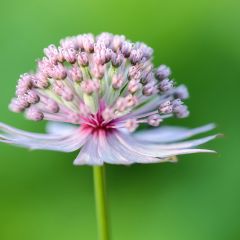
Astrantia major - Great Masterwort
- Flowering time July to October
- Height at maturity 90 cm
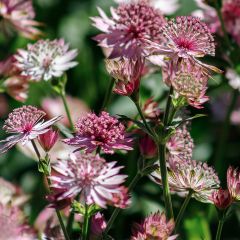
Astrantia major 'Roma'
- Flowering time July to October
- Height at maturity 60 cm
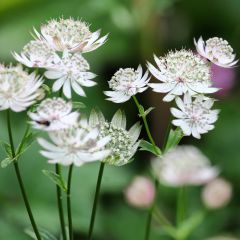
Astrantia major Shaggy - Masterwort
- Flowering time July to October
- Height at maturity 60 cm
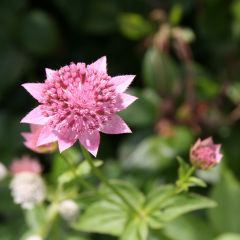
Astrantia maxima
- Flowering time July to October
- Height at maturity 40 cm
Discover other Astrantia - Masterwort
Planting
Where to Plant Masterwort?
It thrives throughout France, except in coastal areas (Astrantia cannot tolerate soil salinity), Mediterranean climates, and regions with sandy or stony soils.
Masterwort prefers partial shade, typically in spots with morning (east-facing) or late afternoon sun, or under dappled sunlight filtered through trees.
It can tolerate full sun (except in southern regions) if the soil remains moist in summer without drying out. However, we recommend planting it where it will look its best: sheltered from scorching sun in partial shade behind a hedge or under the light shade of a tree.
It thrives in deep, cool, rich, heavy or well-drained soils: ideally, good compost, fertile clay soil, or woodland soil. Tolerant of soil acidity (neutral, acidic, or alkaline), it adapts to most soil types, except very poor and free-draining soils (extremely sandy or stony), where it may dry out in summer. In such cases, flowering stops, and foliage partially withers. It usually recovers with autumn rains, but prolonged drought can kill it.
It prefers well-drained soil. If your soil is very heavy, plant it on a slight slope or mix in compost at planting time.
Originating from mountainous regions, Astrantia retains excellent hardiness. It withstands temperatures below -15°C without issue, making it suitable for cold climates.
Windy conditions don’t harm flowering but can damage foliage, causing partial blackening and reduced elegance—better to plant it in a sheltered spot.
Container cultivation is not recommended: as it prefers cool, deep soil, it struggles in confined spaces, much like peonies. However, it can succeed in deep pots (at least 20 cm) in shaded spots with careful summer watering.
When to Plant?
Masterwort can be planted year-round, preferably during cooler, well-watered periods, avoiding deep frosts: September to November in autumn, or March to May in spring.
How to Plant?
Prepare the soil by digging a hole about 20 cm deep and wide. Loosen the soil well.
If your soil is challenging (stony, sandy, or very heavy), mix in several litres of compost and add a base amendment or nitrogen-rich perennial fertiliser (e.g., crushed horn).
Water thoroughly after planting to remove air pockets. Monitor watering closely for the first month—the soil must not dry out. In its first summer, water once or twice weekly during droughts. In subsequent years, watering is unnecessary unless drought persists or planted in full sun.
Plant 4 to 5 per m2, spaced 30–40 cm apart. At maturity, one plant makes a striking display, but grouping 5–7 creates a spectacular effect.
Maintenance
Rarely targeted by pests, Masterwort is a very robust plant. In spring, young shoots may sometimes be attacked by slugs. Protect them, preferably with an organic slug repellent (such as wood ash, lava powder or ferramol).
Masterwort is not prone to diseases: it may occasionally be affected by aphids or powdery mildew, but usually without serious damage.
If the soil tends to dry out in summer, mulch in late spring to maintain some moisture at the base (see our article on summer mulching here); however, winter mulching encourages slug proliferation.
Cut back flower stems as they dry to encourage new leaf growth.
In autumn or preferably in late winter, you can cut back the dried foliage to ground level.
Propagation
Sowing Astrantias
You can resow the seeds you produce once the stems have dried… or purchase them in packets.
Direct sowing in the garden is possible, but sowing in seed trays is recommended for better results.
Even in pots, sowing Astrantias remains in most cases a relatively complex and unpredictable operation, best suited for experienced gardeners: the seeds require a cold period (cold stratification) to germinate properly. Germination takes 6 to 8 weeks with controlled temperature and watering.
Dividing Astrantias
Unlike sowing, dividing Astrantias is easy and risk-free. It’s an excellent method for mass planting. Divide well-established clumps, typically after 4 years of growth, then every two years. This will extend their lifespan indefinitely.
In early spring, before new leaves emerge (late February or March), dig up the rootstock with a spade. Using the spade blade, a saw, or a large knife, divide the rootstock into 3 to 5 sections depending on its size, and replant immediately, spacing each division at least 30 cm apart.
Association
The Masterwort pairs beautifully, even exceptionally well, with a multitude of plant varieties. In the garden, it plays a role similar to the “little black dress” in a woman’s wardrobe: it fits seamlessly into beds of various styles, invariably adding a touch of elegance without any risk of a fashion faux pas.
It is a classic, must-have perennial in English gardens, where it is often found in white/pink/blue combinations with other perennials. It is highly prized in contemporary prairie gardens. It’s a near-universal solution for dressing the base of a rose bush, shrub, or hedge. And of course, it is one of the centrepieces of shade gardens and white gardens.
Masterworts also make stunning cut flowers, thanks to their long stems. The blooms remain beautiful for 2 to 3 weeks and can also be dried for lovely arrangements: simply hang the cut stems upside down to dry for a few days. They pair particularly well with roses and wildflowers for a rustic bouquet, or with the foliage of Lady’s Mantle or Heucheras for a romantic bouquet.
Useful resources
- The finest range of masterworts in France is available here
- An excellent article by renowned landscape designer Didier Willery in L’Ami des Jardins
- A summary of cultivation requirements,
- Some beautiful planting combinations with Masterworts
- Masterworts, the largest umbels
- Our advice sheet: Mulching – why and how
- Our video guide: How to plant alpines in a rock garden
- Our advice sheet: Choosing a Masterwort
- Our advice sheets: White-flowered Masterworts and Pink-flowered Masterworts
- Discover Olivier’s favourite: Masterworts
Frequently asked questions
-
My Masterwort isn't growing... or barely. What should I do?
Be patient, it's normal! Slow-growing (which explains the rather high price of plants in the trade), Masterwort is quite sluggish to establish: often, the novice gardener is disappointed to see their plants, planted in spring, remain relatively weak and poor in flowers during the first year. Adding fertiliser at planting time helps them get started... and then patience is key! The explosion of flowers from the second year onwards will reward them.
-
My Astrantia isn't flowering, what should I do? My Astrantia stopped flowering in July, is this normal?
This isn't normal. A Masterwort typically flowers from May or June through September. It's likely lacking water.
If it isn't flowering, it's usually due to insufficient water: soil that's too dry, free-draining, or overly sunny—or a combination of these factors. The solution is simple: mulch... and water regularly!
Another possible cause is planting in too shady a spot, with deep shade and no sunlight at all. In this case, you should move it in late winter to a partially shaded area.
Sometimes, you may notice a shortened flowering period: by July, blooming slows and stops by mid-summer. In 99 cases out of 100, the reason is lack of water—soil that's too dry, free-draining, or exposed to too much sun.
Note: Cutting back spent flower stems can extend the flowering period by encouraging new blooms to form.
-
I sowed Astrantia seeds. The colour is different from what I expected. Is this normal?
Yes. Seedlings are never uniform, and differences in colour, sometimes significant, are inevitable. Dividing the plants, on the other hand, preserves the exact hues of the mother plant's flowers.
-
The leaves of my Masterwort are half-dry. What should I do?
It's not pretty... but no matter. It probably got thirsty or suffered from drying winds. Water if the soil is dry. And of course, in autumn, it's inevitable because the deciduous foliage of Astrantia disappears in winter: it gradually dries out from September-October onwards.
- Subscribe!
- Contents
